By William E. Welsh
In the late spring of ad 732, an 80,000-man-strong Muslim army spilled northward through gaps in the western Pyrenees onto the verdant, gently rolling landscape of Gascony. The invaders crossed the 3,800-foot Roncesvalles Pass, shedding extra layers of clothing they had worn as they passed through the snow-covered mountains. As they descended, the air became pleasantly warm in the Duchy of Aquitaine and they were greeted by heavy rains in sharp contrast to the desert air with which they were more familiar.
The supremely confident warriors were looking to slake their thirst for riches by looting the Christian abbeys, churches, and towns in the area. Although by rights one-fifth of the spoils belonged to the Umayyad caliph in Damascus, each man in the ranks was also assured some portion of the plunder. The invading army, led by Abd er-Rahman, governor of al-Andalus, the Muslim-controlled territory on the Iberian Peninsula, reflected the sheer breadth of appeal of the Prophet Muhammad and his teachings. Within its ranks were Arab professional soldiers, Persian warriors, Turkish adventurers, and Berber tribesman. The mounted invaders, armed with lances and shields, wore chain mail beneath loose-fitting, brightly colored robes. They protected their heads with egg-shaped helmets, while the poorer Berbers, toting spears and swords but lacking armor, wore turbans and drab robes.
Abd er-Rahman and his army intended to subjugate and punish Aquitaine’s ruler, Prince Eudes, who had resisted the steady encroachments into Aquitaine by the governor and his Muslim minions for the past several years. The vacuum left by the dissolution of the Western Roman Empire had set the stage for the dramatic spread of Islam by armed conquest across the shores of North Africa in the 7th century. Muslim warriors of the Umayyad caliphate of Damascus, the second of four Islamic caliphates established after Muhammad’s death, reached the shores of the Atlantic in ad 710. Seeking more plunder for the caliph (and for themselves), the invaders cast their eyes on the Iberian Peninsula to the north.
At the time, the Visigoths controlled the Iberian Peninsula, having settled there in the 5th Century. They were ruled by King Roderic, whose sovereignty was disputed by rival factions in Septimania, a former province of Rome just northeast of the Pyrenees. Taking advantage of the discord, the Umayyad governor of North Africa, Musa ibn Nusair, assembled an invasion army bound for Iberia. Lacking their own transport, the Muslims found a willing Byzantine official who bore a grudge against Roderic. Because of the lack of transport and the attendant difficulties of supporting an amphibious invasion, Damascus granted permission for only a small expedition consisting of 400 men. The subsequent success of the expedition, including the sack of Algeciras, and the knowledge that Roderic was tied down in a protracted conflict with Basque tribesmen in northern Iberia, fed the Muslim thirst for even larger riches.
The following year Musa entrusted a second invasion, this time comprising 7,000 Berbers and Arabs, whom the Europeans called Saracens, to Berber leader Tarik ibn Ziyad. Roderic perished fighting the Muslim invaders, and Musa crossed to Iberia to administer the conquered areas. By 712, the Muslims had subjugated most of the population of Iberia, with the exception of the Asturias and the Basques. Driven by their unquenchable thirst for plunder, the Umayyads began raiding north of the Pyrenees into the sprawling Duchy of Aquitaine. To the northeast lay Septimania, the last bastion of the Visigoths. At the time, Aquitaine was nominally ruled by the Merovingian Franks.
Duke Eudes, the ruler of Aquitaine, had taken advantage of civil strife in the Frankish kingdom following the death of the Frankish leader, Pepin of Herstal, to expand his control of the borders of Aquitaine and bestow upon himself the title of prince, a self-anointing act that did not sit well with the Franks. Pepin had ruled the Frankish kingdom from 679 until his death in 714. Before dying, Pepin had designated his young grandson, Theobald, as his heir. Fearing that Pepin’s illegitimate son, Charles, would seize power, Pepin’s wife had Charles imprisoned. He escaped and fought a series of battles over the next several years, during which time he consolidated his power and crushed his opponents in the tripartite Frankish kingdom of Austrasia, Neustrasia, and Burgundy, while also reasserting his control over key dependencies such as Aquitaine. By 723, Charles was firmly in control of the Frankish kingdom and serving as mayor of the palace, as his father had done before him. He spent the next year fighting the Saxons and Bavarians on Austrasia’s eastern flank.
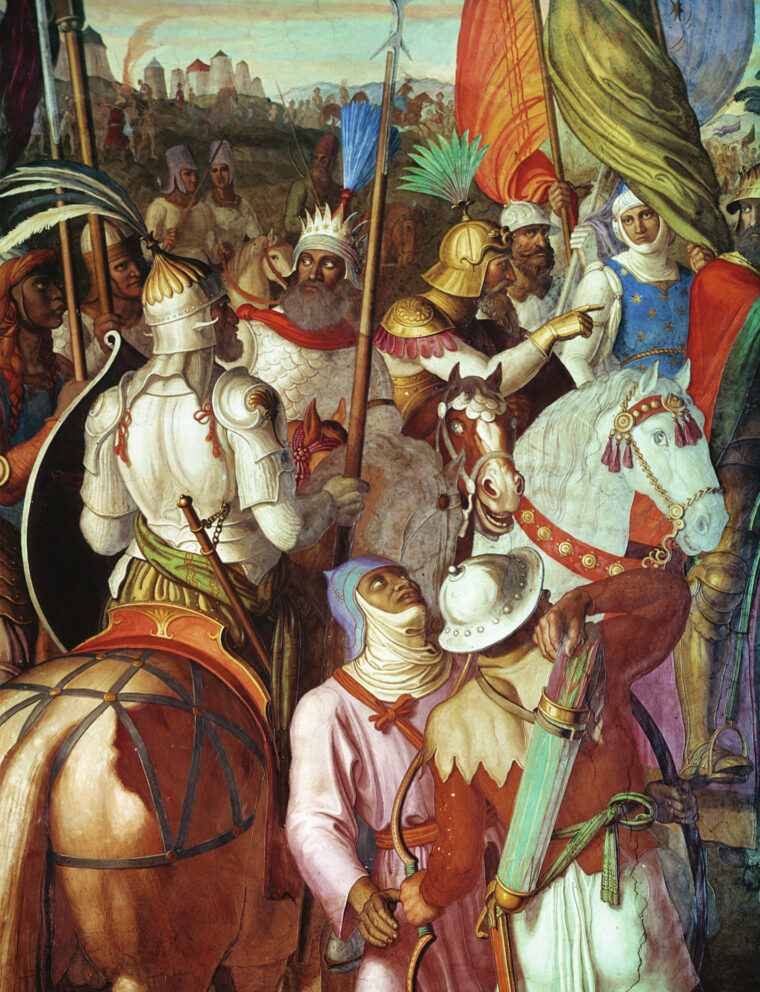
The Umayyads began launching large-scale raids north of the Pyrenees in 717, and two years later they captured the port of Narbonne in Septimania, transforming it into an Islamic city. The successful capture of Narbonne led to even greater schemes of conquest. In 721, the al-Andalus governor at the time, al-Samh ibn Malik al-Khawlani, led a large force bent on conquering all or part of Aquitaine by marching on the key city of Toulouse. The confident Muslims brought with them a long train of siege weapons and a large number of camp followers. After crossing the eastern Pyrenees in the springtime, the invaders laid siege to Toulouse. Meanwhile, Eudes set about gathering a relief force composed of Gascons, Basques, and Visigoths.
Eudes attacked the Muslim forces around Toulouse on June 9, scattering and overrunning them as they sought to withdraw. It was a decisive victory, one that greatly enhanced his prestige. The Muslims, however, were by no means through with their military efforts in the region. Four years later they closed their grip on Septimania by capturing the fortresses of Carcassonne and Nimes and driving the Visigoths from their last holdings. These would serve as bases for far-ranging Muslim raids into Burgundy.
Eudes, who found himself in the unenviable position of being sandwiched between the Muslims in al-Andalus and the resurgent Frankish kingdom under Charles, entered into an alliance in 729 with Munusa, the rebel governor of Cerdagne, a district in the eastern Pyrenees, to augment his army in future conflicts. To parry the growing strength of the Franks, Eudes also began meddling in Frankish political affairs.
As part of an ongoing attempt to subjugate the lands bordering the Pyrenees, Abd er-Rahman invaded Cerdagne and forcibly removed Munusa as a threat. Believing it was imperative to punish Eudes for daring to resist Muslim encroachments, er-Rahman began assembling an army in the western Pyrenees at Pamplona to remove Eudes as a threat once and for all. Professional soldiers flooded into the encampment from throughout al-Andalus and from North Africa, giving er-Rahman a sizable army. At the same time, Charles shifted his attention from the Frankish kingdom’s eastern frontier to its western one, launching two punitive raids in 731 on northern Aquitaine and ultimately sacking Bourges.
Keenly aware of the fate that had befallen al-Samh before the gates of Toulouse, er-Rahman purposely chose not to follow the same invasion path through the eastern Pyrenees. Instead, the high Roncesvalles Pass offered the Muslims a more direct route to Bordeaux, which Eudes was bound to defend. When they reached level ground, the Muslims divided into two columns. The main column, led by er-Rahman, took an inland route, stopping north of Aire to burn the abbey of Saint-Sever-de-Rustan. Meanwhile, a smaller column took a coastal route of march, stopping to pillage Bayonne and Dax before resuming its march toward Bordeaux. As the two columns advanced, they met no resistance. Vastly outnumbered, the small garrisons in Gascony had fled north to the Garonne River, where they planned to join Eudes’s main army to defend Bordeaux.
Eudes was presented with two choices for doing battle with the Muslims, both of which favored the invaders. If he fell back on Bordeaux, he risked being trapped on the Medoc peninsula and defeated outside the city walls. Yet if he gave battle in the open countryside in the Garonne valley, his army was likely to be overwhelmed by er-Rahman’s much larger force. Eudes opted for the latter choice, and in early June he suffered a decisive defeat along the banks of the Garonne. The remnants of his army retreated northward to the Dordogne River, a tributary of the Garonne, leaving Bordeaux uncovered. The Muslims immediately plundered Bordeaux, extracting from the city a large treasure of booty that included countless gold objects richly decorated with gems and pearls. They left the town in smoldering ruins when they departed in late June.
While Eudes raised new forces from northern Aquitaine for another clash with the Muslims, er-Rahman rode east along the southern bank of the Garonne until he reached the town of Agen, midway between Bordeaux and Toulouse. There, he crossed the wide river, defeated the town’s small garrison, and added still more plunder to his growing baggage train. Meanwhile, smaller raiding parties gathered additional booty from nearby towns and churches.
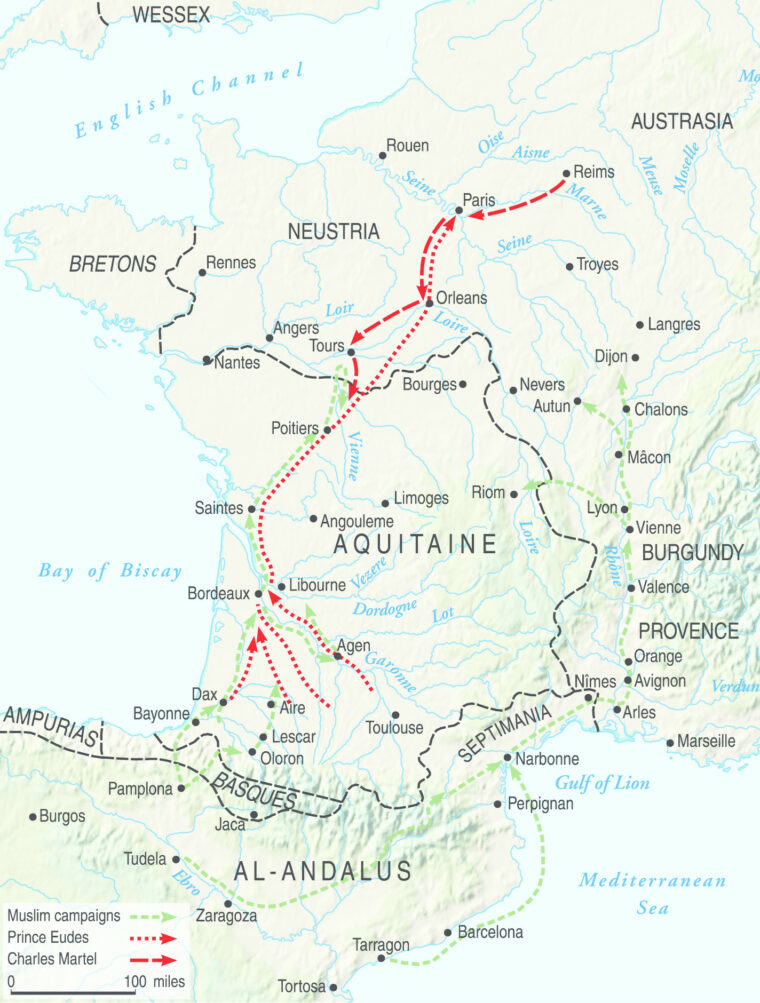
The Muslim leader turned his army back west to do battle once again with Eudes. His scouts found Eudes’s army in a defensive position on the north side of the Dordogne, defending a bridge on the Roman road to Saintes. After receiving this information, er-Rahman sent one wing of his army on a wide flanking march upstream of the Franks, which brought his horsemen in on their flank. A major battle occurred at the junction of the Garonne and Dordogne Rivers, and Eudes once again was soundly defeated. No longer able to offer substantial resistance to the advancing Muslims, Eudes rode north with his retainers into the heart of the Frankish kingdom to petition Charles for aid in defending Aquitaine.
News of the Muslim victories in Aquitaine reached Charles while he was in the midst of a campaign against the Bavarians along the Danube River. With Muslim forces operating deep in Aquitaine and Burgundy, Charles rode first to Reims and then on to Paris. In a no doubt uncomfortable meeting with Eudes, he agreed to help—provided that Eudes pledge his allegiance to Charles and agree to maintain Aquitaine as a Frankish dependence rather than an independent principality. After the meeting, Charles issued a summons calling upon all able-bodied men throughout the kingdom to defend the realm. The army assembled at Paris and marched to Orleans and Tours to protect wealthy church properties that were likely targets of marauding Muslims. Charles dispatched advance forces to guard the Basilica of St. Martin, which lay outside the city’s protective walls.
Tours itself was in no immediate danger. The Muslims spent the next three months encamped in central Aquitaine. During that time, they plundered the surrounding cities of Saintes, Perigueux, and Angouleme. In a systematic manner, er-Rahman’s troops stole treasure and artifacts from church properties and dismantled and burned fortifications to remove any local resistance to their authority. Once they had secured all the treasure they believed was to be had in central Aquitaine, the invaders broke camp at Saintes and marched northward via the Roman road toward Poitiers.
Poitiers, a key crossroads in northern Aquitaine on the Clain River, was situated about 60 miles south of the Neustrian border. The second largest town in Aquitaine after Toulouse, Poitiers was surrounded by an inner wall built during Roman times and an outer wall constructed by the Visigoths. Scattered around the city and its outskirts were a number of important religious structures, including the abbey and church of Saint Hilaire and the funerary basilica of Saint-Radegonde. Saint Hilaire, which lay beyond the protection of the outer wall south of the city, was adorned with gold mosaic and undoubtedly would be a prime target for the treasure-seeking Muslim raiders.
A network of tributaries of the Loire River was located east of Poitiers. Among these tributaries, which had their headwaters on the northwestern slope of the Massif Central, were the Vienne, Cher, and Indre Rivers. On their way to join the Loire, the tributaries flowed through a landscape that consisted primarily of upland pastures and valleys and ridges blanketed by thick forests.
As expected, the Muslims attacked the lightly defended Saint Hilaire in mid-September and carried off its religious treasures. At that point, er-Rahman decided to forego a siege of the walled city in favor of sacking Saint-Martin, outside Tours. The Muslims had learned from locals that Saint-Martin contained even greater wealth, and despite the risk inherent in invading another dominion of the Frankish kingdom, they continued north in late September marching past the fortifications of Poitiers. While the largest column led by er-Rahman marched along the Roman road, smaller columns advanced toward the Loire River on less direct routes to the left and right of the main column.
As they marched north along the Roman Road with the Clain River, a tributary of the Vienne, to their left, the Muslims passed by the ruins of a Roman settlement at Vieux-Poitiers that included an amphitheater with a tower that afforded a bird’s-eye view of the surrounding farmland. When er-Rahman reached the village of Cenon on the Vienne River, he paused for a time before crossing. Scouts were sent up and down the river and across to the north bank to make sure Frankish forces were not in the vicinity. After it was determined that a safe passage could be made, the main body of the Muslim army crossed to the north bank.
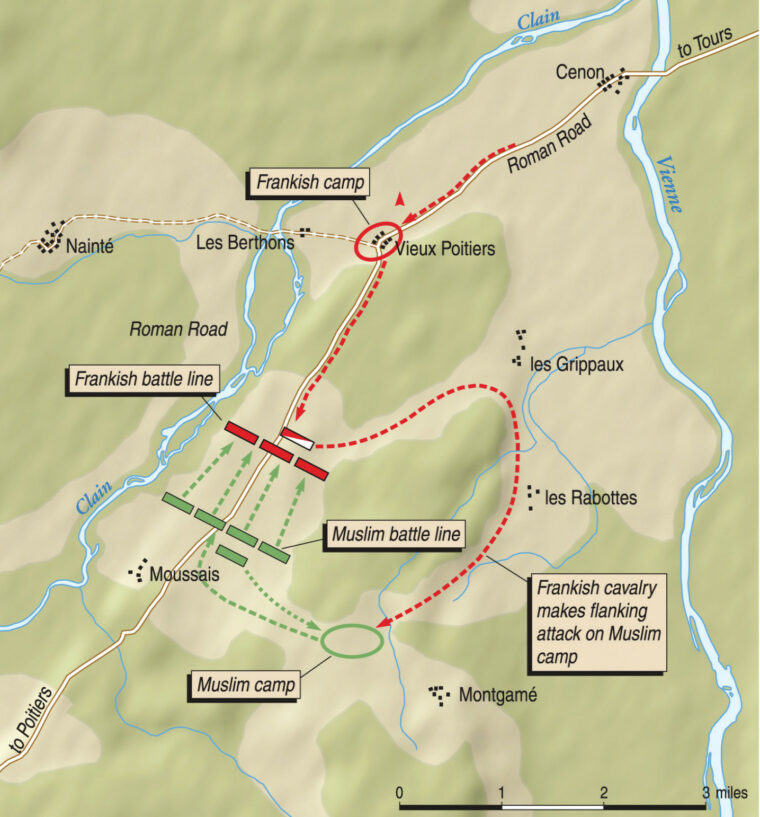
From Cenon, er-Rahman marched north to the village of Port-de-Piles, where he halted his forces on the south bank of the Creuse River, another tributary of the Vienne. In an effort to reconnoiter the road ahead, er-Rahman sent his vanguard across the Creuse. Meanwhile, the Muslim column operating east of the main body ran headlong into a group of Christian pilgrims bound for Rome. They promptly attacked and robbed the pilgrims, leaving a number of the unlucky travelers dead by the roadside.
Advancing cautiously northward in early October, the lead elements of the main Muslim body ran into Frankish positions guarding Tours. Bloody skirmishes foreshadowed a larger battle to come. In a clash with the Franks north of the Creuse River, the Muslim vanguard suffered a serious reverse and was forced to fall back. In another clash farther west, the Franks overran a Muslim encampment near the village of Loudun, forcing the invaders to fall back to a safer position.
In response to these setbacks, er-Rahman ordered his vanguard to fall back behind the Creuse. Still feeling exposed, he withdrew the main body of the Muslim army across the Vienne. In mid-October, the Muslims began constructing a fortified camp on high ground between the Vienne and Clain Rivers just north of marshland along a stream that emptied into the Clain. The military encampment, known as a khandaq, was protected on all sides by ditches and guarded around the clock. Just beyond the ditches were thick woods. A gap in the woods to the west led toward the Roman road, while a gap to the northeast led to two small villages in the Vienne River valley. As the Muslims fell back, Charles ordered his army to advance to the Vienne and halt opposite Cenon.
While the Muslims built their khandaq, the Franks crossed the Vienne and began a cautious advance southward along the Roman road. The Franks made camp at the Roman ruins located on the western side of the old road. They used the tower that was part of the Roman amphitheater as an observation post. For the better part of a week, the two armies warily observed each other, neither willing to launch an attack.
On Saturday, October 25, Charles ordered his troops to form a defensive line astride the Roman road just south of the ruins at Vieux-Poitiers on a narrow tract of cleared land. The position allowed Charles to anchor both flanks in dense woods. By securing his flanks, the Frankish commander ensured that the Muslim cavalry would not be able to ride around his army and fall on his main line from the rear.
The Frankish army, numbering about 30,000 men, was divided into four divisions. It consisted of Frankish infantry, both mounted and on foot, and a body of irregular cavalry composed of mounted bands of Bretons, Basques, and Gascons that was commanded by Eudes. Rather than pit his less-agile cavalry against the well-trained Muslim horsemen, Charles ordered the mounted infantry to dismount and take their place in one of three divisions that would form a formidable phalanx to await the Muslim attack. The soldiers in the main line of battle stood shoulder to shoulder in order to leave no gap through which their line might be breached. The fourth division, under Eudes, formed a rear guard that was stationed behind the main line and had orders to respond to any Muslim cavalry that might be clever enough to find a way around or through the front line.
Just after sunrise, the Muslim army marched west until it reached the Roman road. It then formed for battle just beyond the village of Moussais-le-Bataille. In keeping with Muslim tradition, the army was organized into five divisions consisting of a center, two wings, a vanguard, and rear guard. The rear guard did not march into battle, but stayed behind to protect the khandaq. Muslim tactics were to overwhelm their adversaries by moving swiftly across open ground, outflanking the enemy’s position, and disrupting the opposing forces so that the enemy could be ridden down and slaughtered in small groups.
The Franks fighting under Charles would use tactics that completely negated the Muslim advantage in numbers and speed. The Frankish tactics closely resembled those of the Romans. The Franks used heavy spears and short swords as their main weapons. On the whole, these weapons were heavier than those used by the mounted Muslim forces. The Franks were clad in chain-mail shirts or leather jerkins reinforced with metal scales. Their primary protection in battle was an impressive round, wooden shield covered in leather that was three feet in diameter. The concave shield, with an iron boss in the center, protected the soldiers from their necks to their thighs. It was used not only for protection against incoming projectiles or slashing swords, but also as an offensive weapon to drive back and batter the enemy in close-quarters combat. To protect their heads, the Frankish infantry wore conical hats angled to deflect blows to the head, whether delivered from an enemy on foot or on horseback.
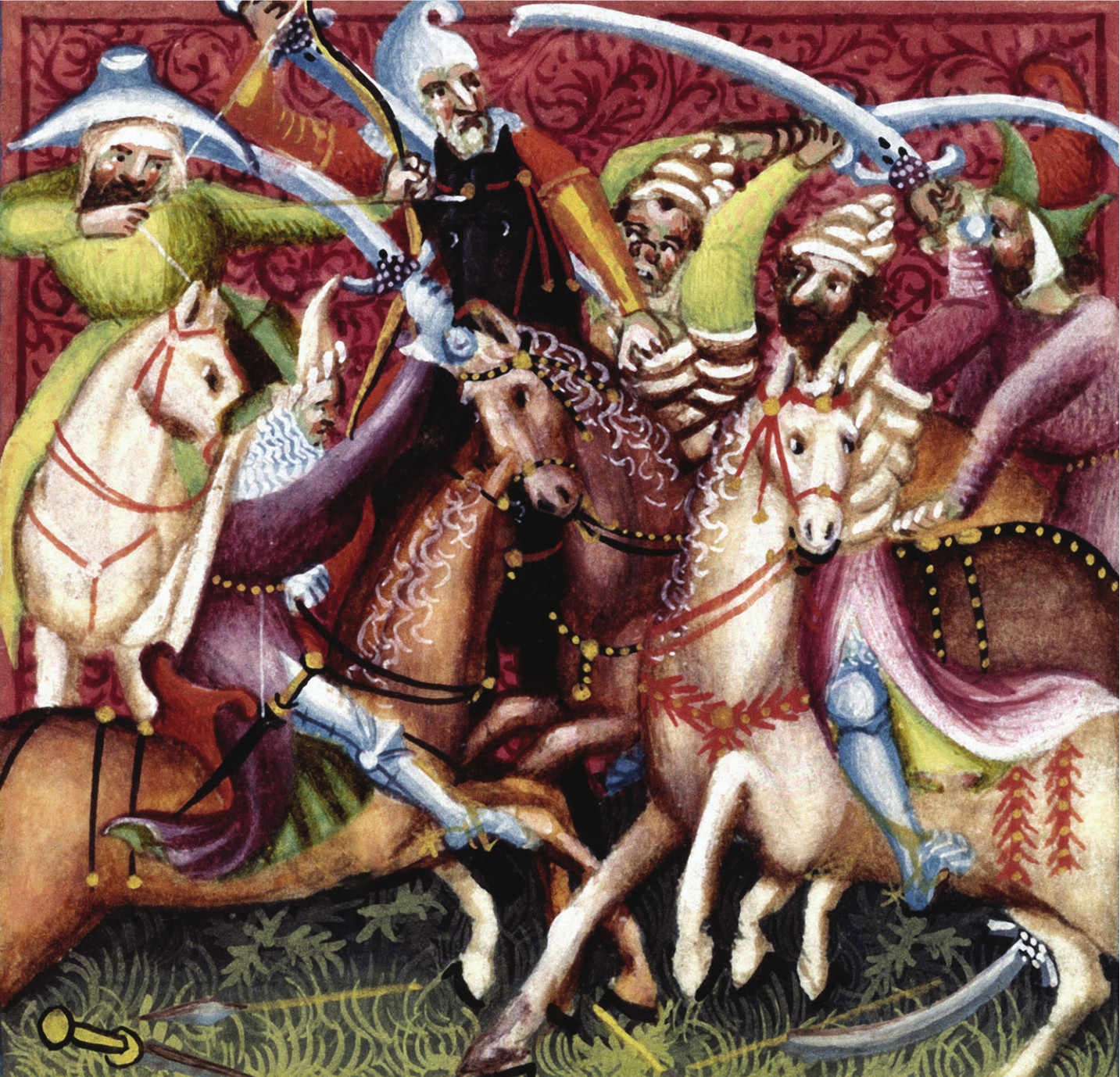
The élan that the Frankish heavy infantry exhibited in battle was derived from the fact that they were free men serving to protect their homeland against marauding invaders. In preparation for the Muslim attack, the Franks presented an unbroken wall of shields. They rested their spears on the ground to impale any Muslim horsemen who might be foolish enough to charge them directly.
The battle began when the Muslims rode at the Franks and began hurling javelins or firing arrows into their ranks at close range. Some brave men rode close enough to slash at the Franks with their swords, a dangerous proposition considering that the Franks was armed with multiple weapons and well protected by their armor, shields, and helmets. The Muslims tried to inflict sufficient casualties to open a gap in the enemy line or, failing that, to entice the Franks to advance to the attack and then work their way inside their lines. At no time did the Muslims try to break the enemy phalanx. It was simply impossible for light cavalry to overrun a strong line of heavy infantry. “The Muslim horsemen dashed fierce and frequent forward against the battalions of the Franks, who resisted manfully, and many fell dead on either side,” wrote an anonymous Muslim chronicler.
The Franks exhibited discipline and control while under attack by a numerically superior foe. “The men of the north stood motionless as a wall,” wrote al-Andalusian chronicler Isidorus Pacensis. “They were like a belt of ice frozen together, and not to be dissolved, as they slew the Arab with sword. The Austrasians, vast of limb, and iron of hand, hewed bravely in the thick of the fight.” When the Muslims came close to their line, the Franks did their best to thrust their spears into the enemy horses and stab and slash at the riders with their swords. They also employed their shields to tear or puncture the enemy mounts. Large numbers of Muslim cavalry were unhorsed near the Frankish line and then either dispatched with swords or trampled as the Franks advanced a short distance to drive back the enemy. Incensed by the constant Muslim looting of their homeland, particularly their churches, the Franks did not take any prisoners.
For most of the day, the fight was an even one, but as the battle wore on into the afternoon the Muslims had yet to punch through the solid Frankish phalanx. As a result of hard fighting, Muslim casualties were particularly heavy. Nevertheless, Charles was concerned about the strength of his line in the agonizing hours that the sun arced slowly across the sky. Late in the day he made a bold decision to switch to the offensive. Taking advantage of the Aquitainians’ superior local knowledge of geography, he ordered Eudes to take his mounted division on a wide flanking march and fall on the enemy’s fortified camp.
Having completed their flank march, Eudes’s men advanced on the Muslim camp from the northeast just before sunset through a passage in the forested country east of the Vienne. The Muslim rear guard detected the enemy on its flank and fell back to protect the khandaq, the riders dismounting and filing into the surrounding ditches. Armed with spears and swords, the defenders were backed by archers with simple bows who fired on the Franks as they advanced.
Eudes’s attack on the Muslim khandaq essentially spelled the end of the main battle. When Muslim front-line forces learned that their camp was under full-scale attack, one squadron of cavalry after another peeled off and rode back toward the encampment. The Muslims were determined to protect the hard-fought treasures amassed during their raids on Aquitaine.
Some of Eudes’s men attacked the khandaq on foot, while others remained mounted in order to hurl their spears and javelins over the defensive barriers. In hand-to-hand combat in the ditches surrounding the encampment, the Franks gained the upper hand in a matter of minutes. As the resistance in front of him crumbled on his front, Charles brushed aside the remaining Muslims and marched his men in good order toward the enemy camp as darkness began to swallow up the last light of day on the bloody hilltop.
“Charles boldly drew up his battle line against them and the warriors rushed in against them,” wrote an observer, the Continuator of Fredegar. “With Christ’s help, he overturned their tents, and hastened to battle to grind them small in slaughter.” While directing the defense of the Muslim camp, er-Rahman was killed by a javelin thrown with expert marksmanship by one of the mounted Gascons or Bretons riding with Eudes.
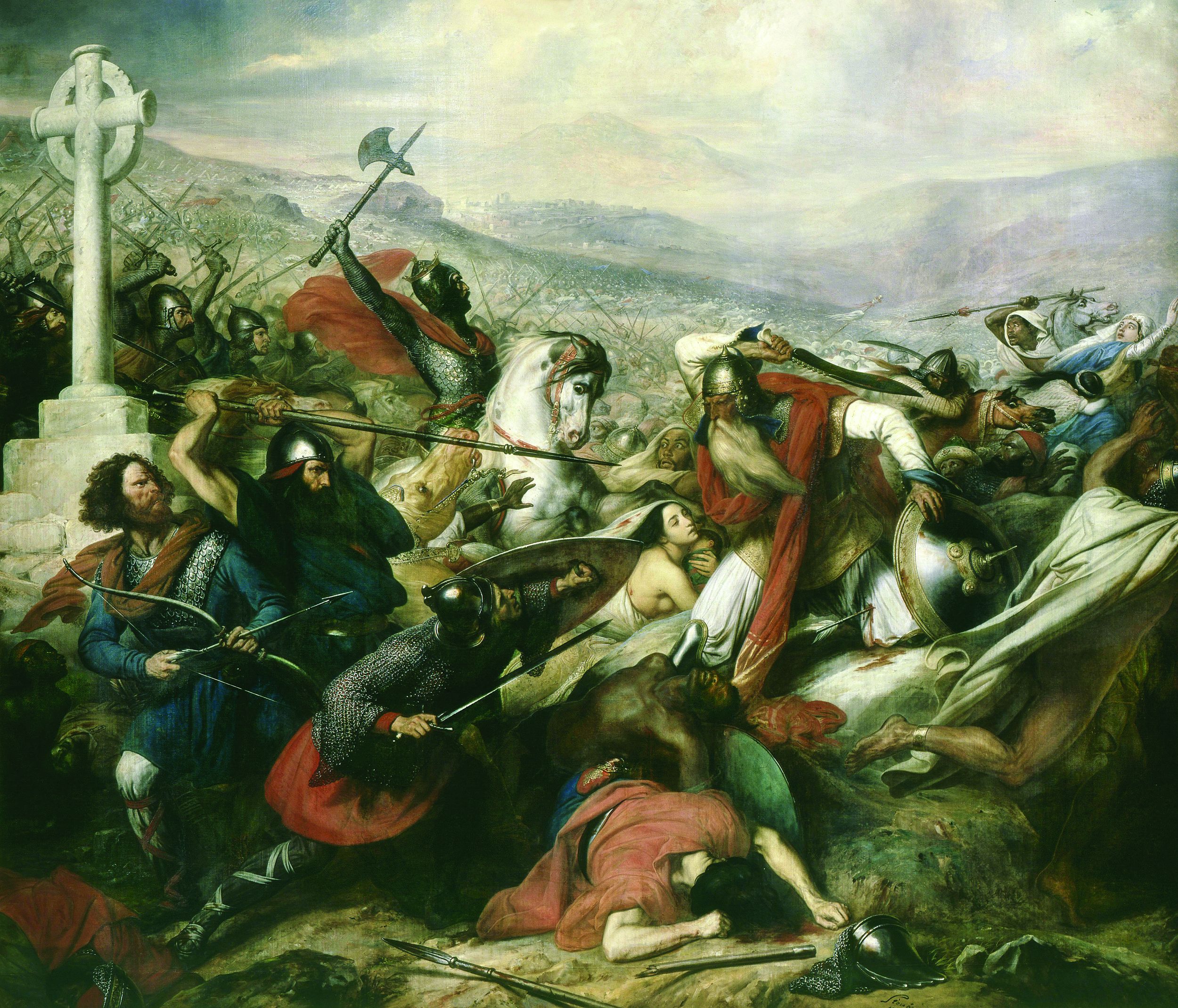
Although Charles’s well-disciplined army killed large numbers of the Muslims, they failed to capture the fortified camp by nightfall. Satisfied with the day’s achievements, Charles ordered his men to quit the field and await the morning’s developments. Meanwhile, learning that er-Rahman had fallen, the Muslims prepared to withdraw southward under the cover of darkness. To hasten their escape, the Muslim survivors made the heartbreaking decision to abandon the baggage train containing their spoils of war. In a skilled move that reflected their military professionalism, the Muslims purposely left their tents standing to deceive the Franks.
On Sunday, the Franks formed up with the intent of resuming the battle. After sending forward several small groups to probe the Muslim defenses, Charles learned that the bulk of the Muslim army had fled during the night, leaving behind their prisoners and plunder so that neither would impede their flight. The rank and file of the Frankish army were spellbound by the treasure they found in the abandoned khandaq. They were anxious to divide the spoils and return to their homes and families with a portion of the recovered loot.
Charles, who was acutely in tune with the mood of his troops, was reluctant to order a pursuit of the Muslims with an unwilling body of men. Furthermore, he feared that the Franks might become strung out during the pursuit, allowing the Muslims to turn on their pursuers and maul them severely. Last but not least, Charles wanted the Muslims to remain a serious threat to the security of Aquitaine, forcing Eudes to focus his political and military efforts against the Muslims rather than the Franks.
Casualties for the battle are difficult to gauge. Muslim accounts state that the Franks lost 1,500 men, but those numbers seem light given that the battle lasted most of the day. In all probability, the Franks lost several thousand men. Muslim casualties were significantly greater than those of the Franks, with the Muslims losing an estimated 10,000 men in the day-long battle.
Charles made a wise decision not to follow the retreating Muslims. The Muslim retreat was by no means the rout of a panicked army. Because of its professional nature, the army’s withdrawal was conducted in a cohesive fashion, with some elements retreating through Aquitaine and others through Burgundy to the safety of al-Andalus and Septimania. The main army turned west toward Burgundy, where it was assisted in its withdrawal by Muslim raiding parties operating deep in the Rhone Valley. Those elements operating west of the Muslim main army slipped across the Dordogne and Garonne Rivers to Gascony and then on to al-Andalus.
After the battle, Charles withdrew through Neustria with his army, but not before replacing the bishops of Tours and Poitiers, both of whom had shown questionable allegiance to him. Eudes, who still had a sizable command despite many months of hard campaigning, marched south, battling the Muslim raiders remaining in Aquitaine as he went.
The battle marked the highwater mark of the Islamic tide that had swept into Western Europe during the Middle Ages. By turning back the Muslims at Tours, the Franks broke the string of Muslim conquests that had spread like a terrible storm through the Iberian Peninsula and beyond. Charles was given the sobriquet Martel (the Hammer) by contemporary chroniclers for the way he had battered his enemies in battle. As the centuries passed, the saga of his defeat of the Muslims at Tours grew in importance until he was credited with nothing less than saving Western Christianity from Islamic subjugation. While there is some truth to the idea, the Muslim raids into Aquitaine and Burgundy were more of a nuisance than a true threat to Western Europe. Charles, for his part, considered rival nobles and hostile clergy in the Frankish dependencies far more of a threat to his rule than the Muslims.
Nevertheless, Charles’s victory at Tours had unanticipated benefits beyond stopping the Muslim advance at the Loire. The Franks enjoyed a significant boost in prestige throughout Europe, particularly in the eyes of the papacy, for having defeated the fearsome Muslims in a set-piece battle. That victory, in turn, laid the foundation for the establishment of the Holy Roman Empire two generations later by Charles’s grandson, Charlemagne. Either way, the Muslims’ halcyon days of raiding Western Europe at will were over.
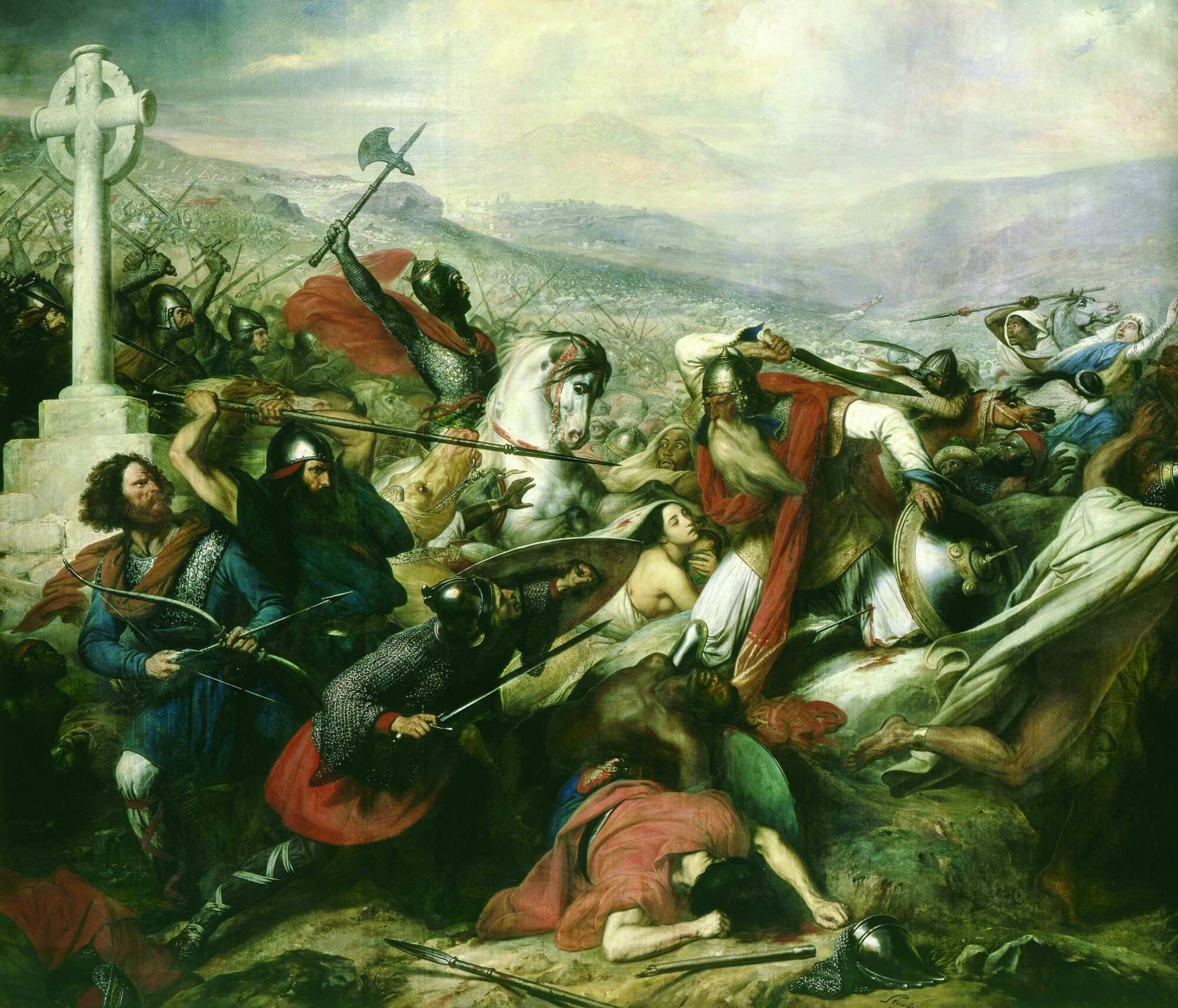
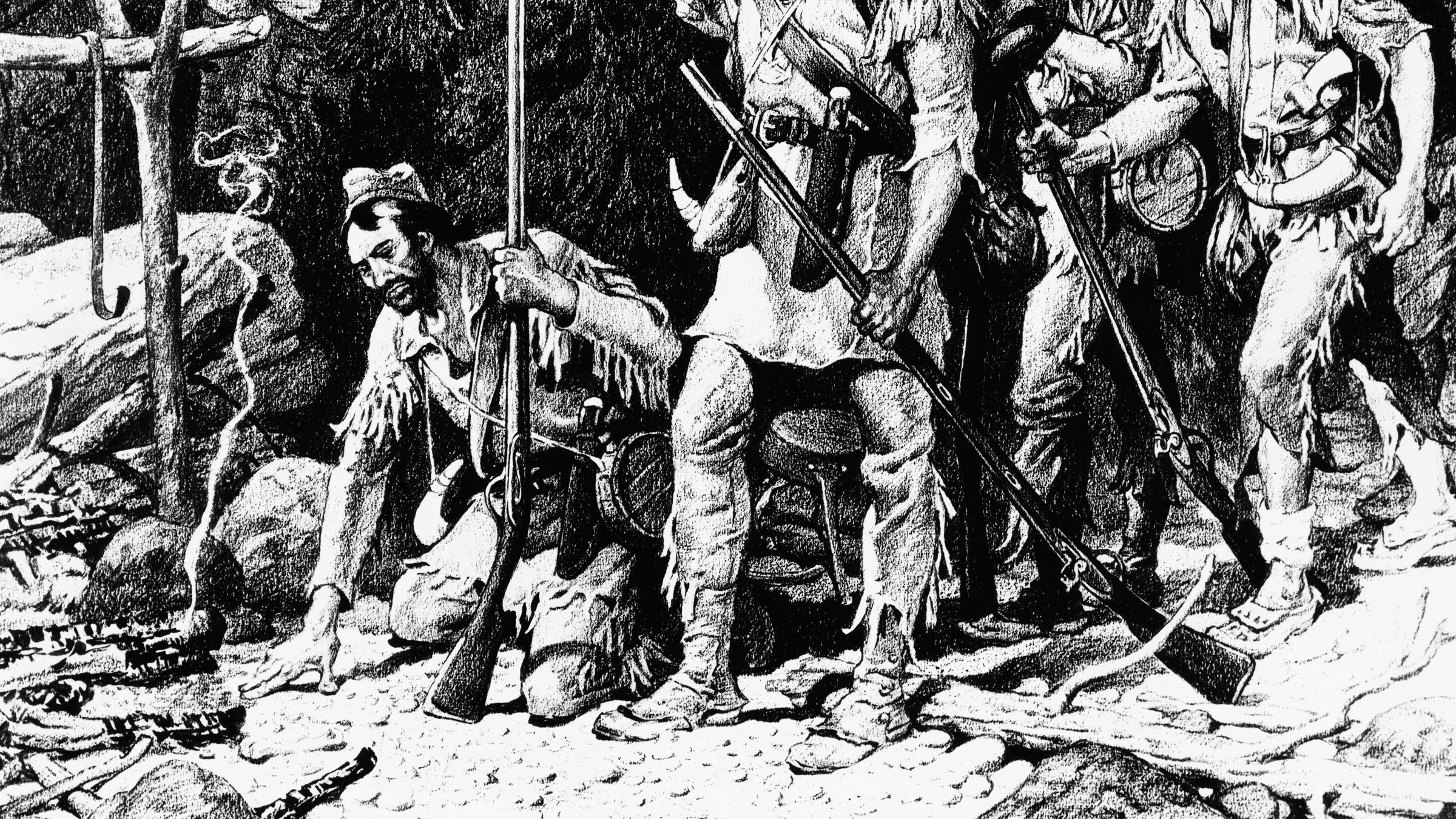
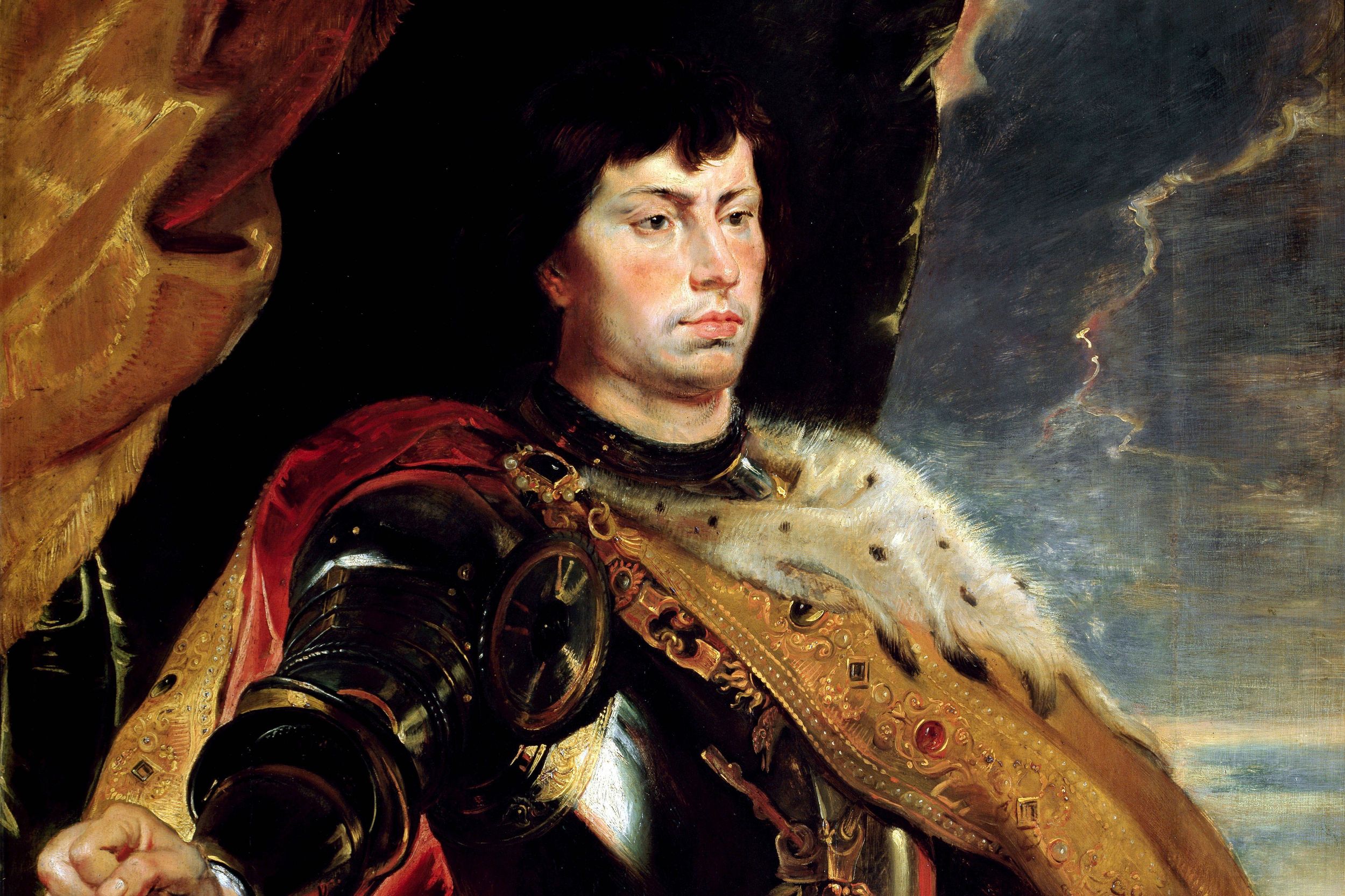
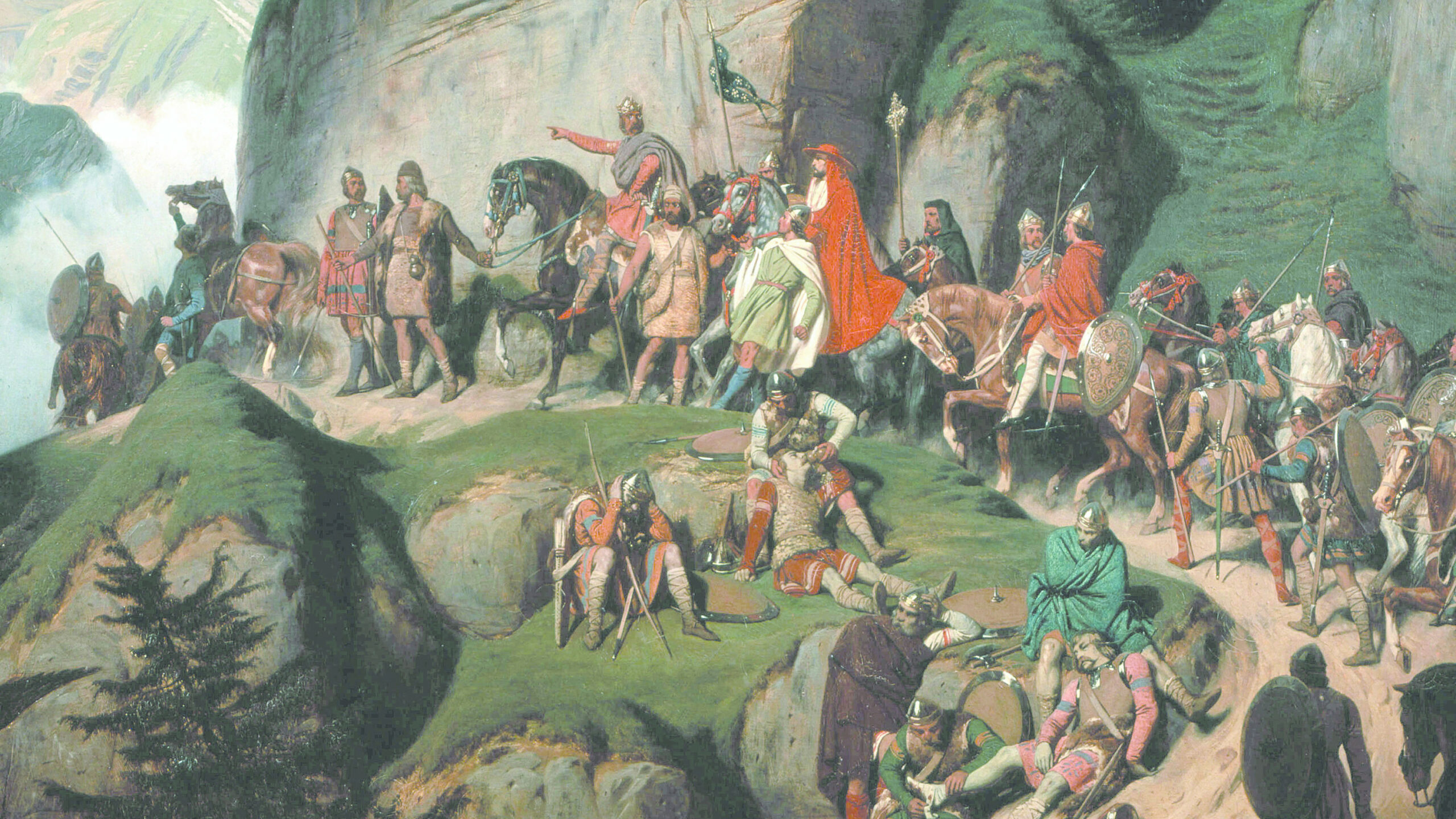
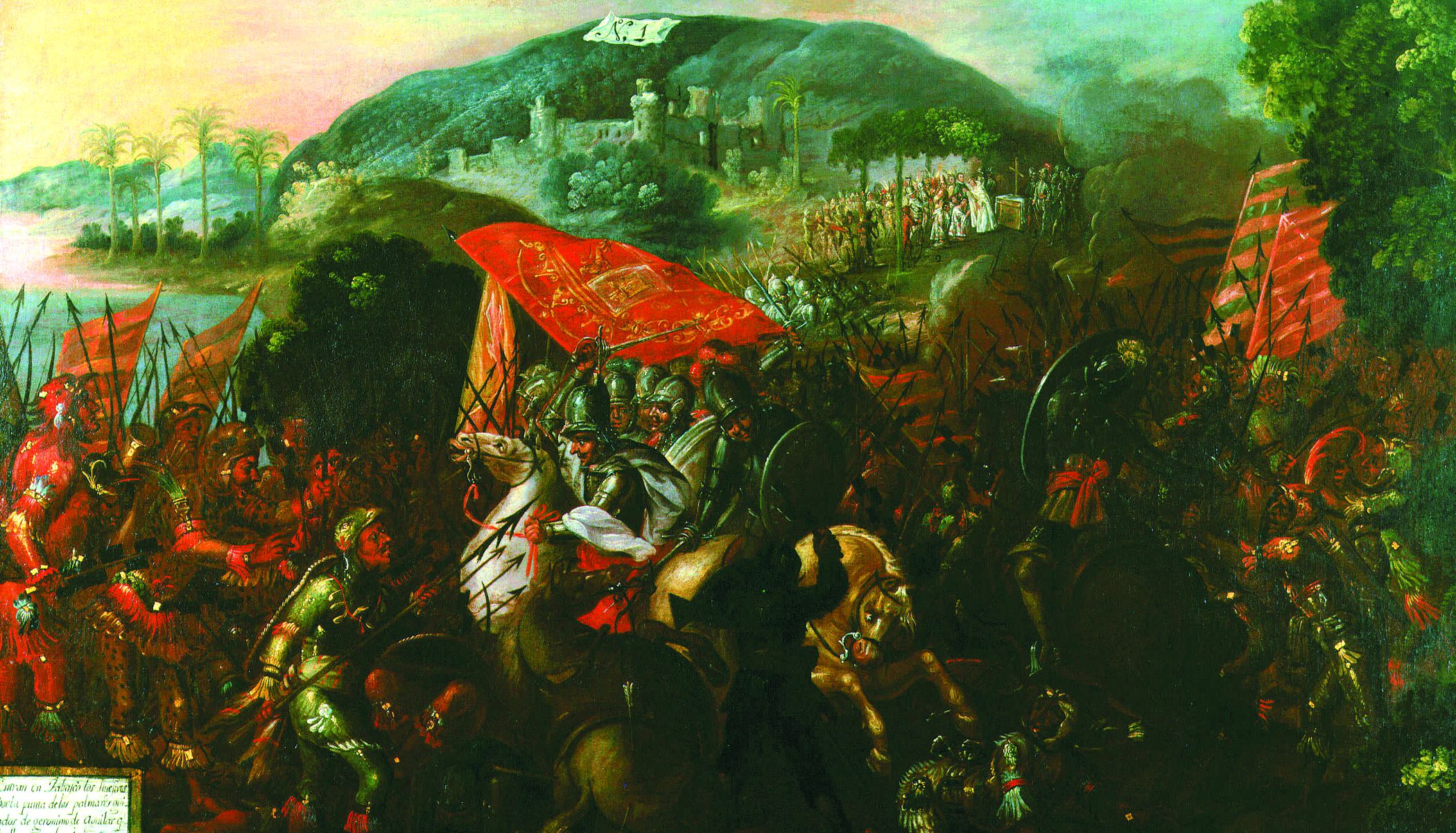
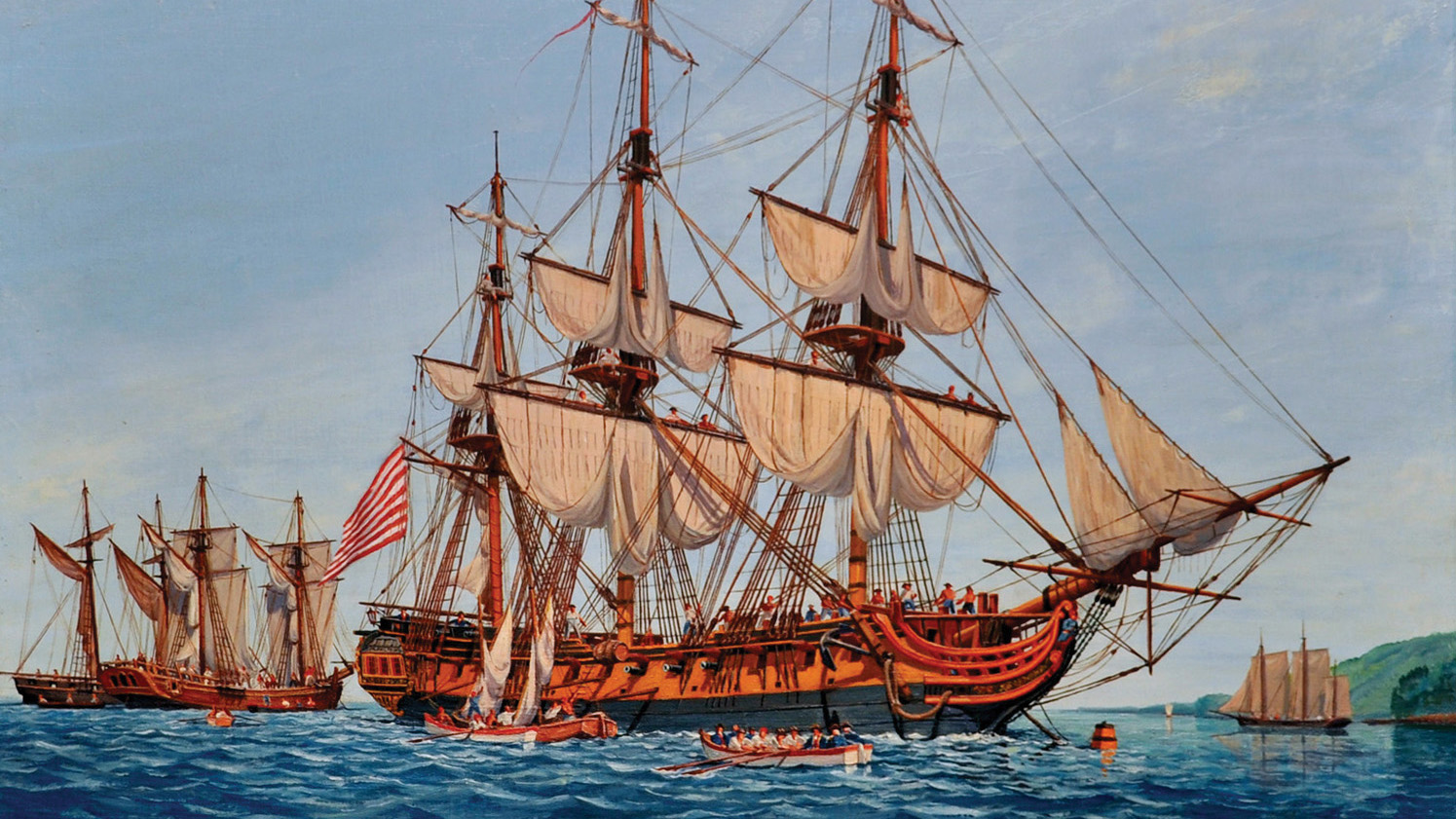
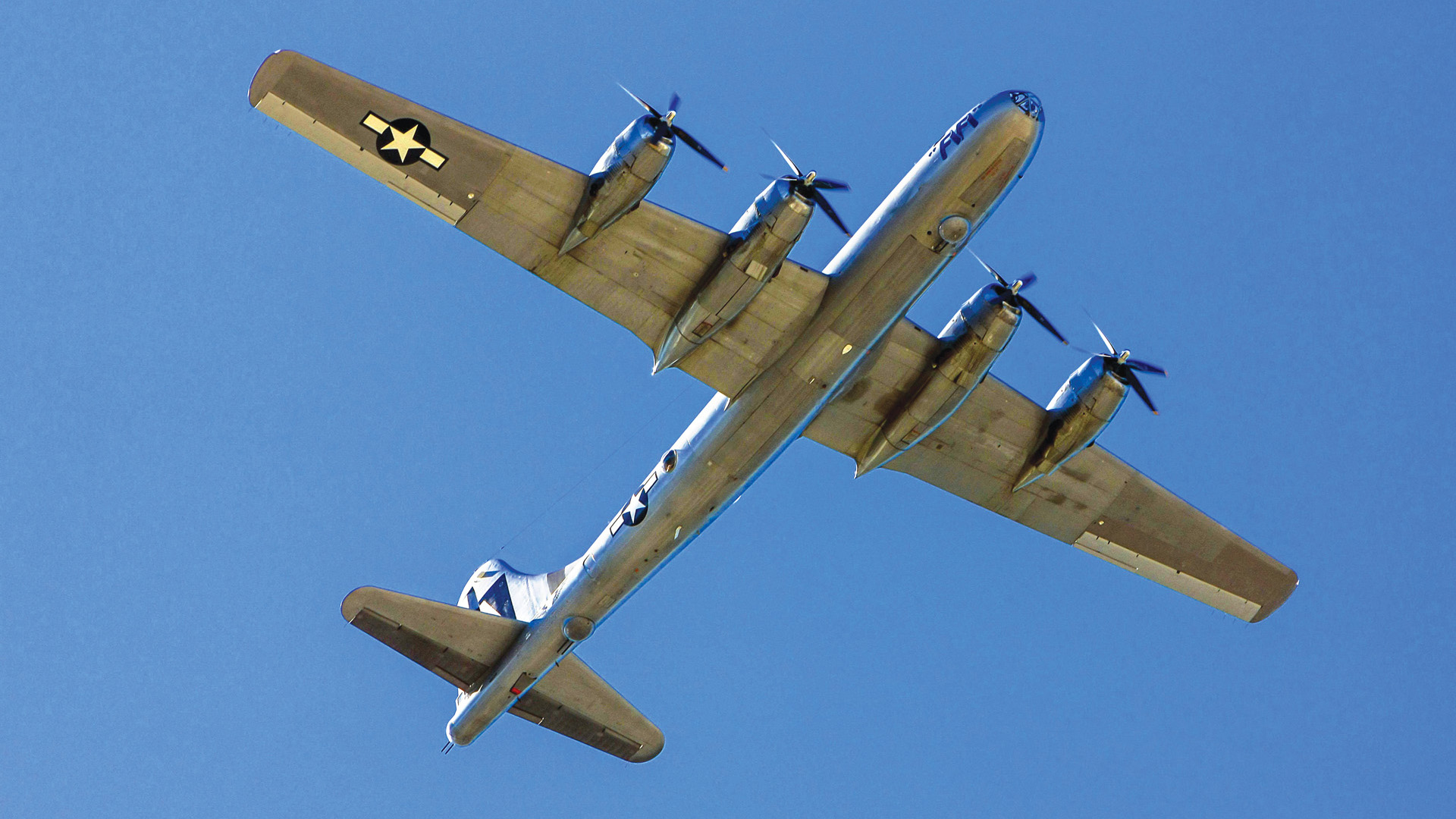
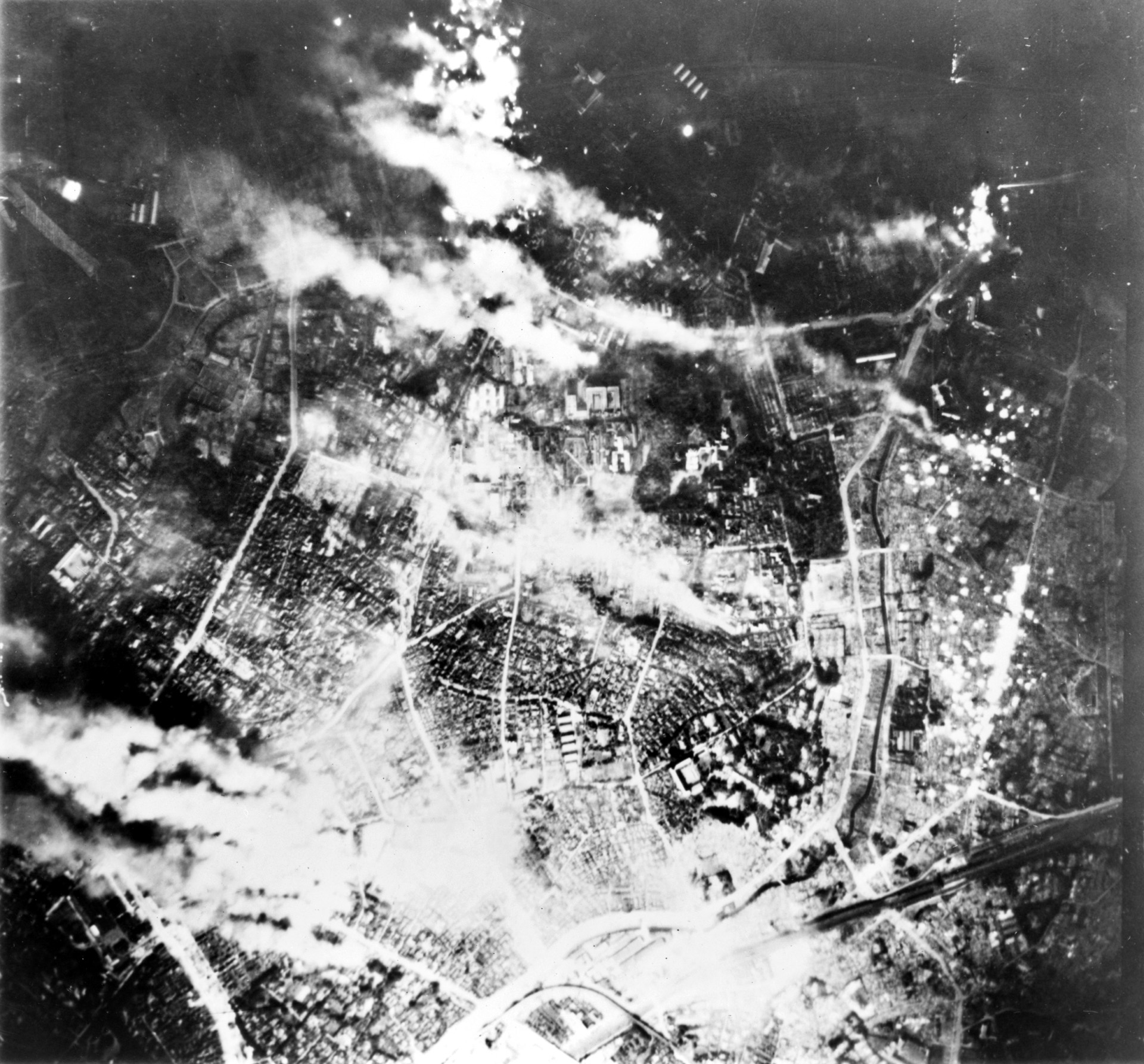
Join The Conversation
Comments
View All Comments